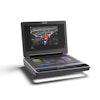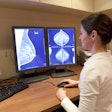
CLEVELAND - On Friday, acting NIBIB director Donna Dean, Ph.D. offered SCAR attendees a glimpse of the inner workings of the National Institute for Biomedical Imaging and Bioengineering. In a SCAR University presentation, Dean described her group as a small number of committed individuals with a start-up spirit. Together they're carving out a niche for imaging within the mammoth bureaucracy of the National Institutes of Health.
The NIBIB was established in December 2000, when President Bill Clinton signed the law authorizing its creation. The move was a triumph for advocates of imaging research, who had to overcome significant opposition to the new institute. NIH officials were reluctant to create a dedicated imaging institute because they felt that imaging research was best conducted within the NIH’s existing structure.
The NIBIB’s first full-year budget gave the institute $120 million in operating funds, and the institute officially began operations in April 2001. It currently has 18 employees, a figure dwarfed by the NIH’s 15,000 workers.
Dean, a longtime NIH staffer, was named acting director in May 2001. The institute expects to announce the appointment of a permanent director some time in the next week, Dean said. Dean will then assume the role of deputy director.
From the start, the task of starting a new institute has been daunting. The NIBIB is the first NIH institute created in the last 25 years with no preexisting infrastructure, Dean said. NIBIB staffers have taken it upon themselves to do things like designing the institute’s logo and Web site (http://www.nibib1.nih.gov).
"We continue to do miracles every day in terms of bringing the institute into being," she said.
The institute’s four main goals, as specified in its establishing legislation, are as follows:
- Develop fundamental research.
- Foster new technology.
- Nurture a new generation of researchers.
- Facilitate collaboration with other disciplines.
The institute’s limited resources mean that it currently doesn’t have its own in-house research program, and its research activities are, for now, limited to funding projects by external researchers. Dean hopes that in the future the NIBIB will be able to develop its own in-house research capability.
The NIBIB has just started funding external grants, and announced its first awards on April 8. They were:
- A $1.4 million grant to researchers at Yale University in New Haven, CT, for the use of functional MRI and spectroscopy to study and treat neocortical epilepsy.
- A renewal grant for $330,000 to the University of California, San Francisco for a study of optical methods for imaging cellular architecture and dynamics.
- A $420,000 Small Business Innovation Research (SBIR) grant to Tribofilm Research of Raleigh, NC, to conduct research on silicone-free low-friction coatings for syringes.
The institute is committing $5 million apiece in grant funding to two specific areas: devices, methods, and contrast agents for in vivo molecular imaging and/or spectroscopy, and sensor development, including sensor arrays and their biointerfaces. Researchers interested in funding opportunities should follow the institute’s Web site, where new grant opportunities will be announced, Dean said.
The institute is also sponsoring training grants, individual postdoctoral fellowships, and institutional grants. It has formed a relationship with the National Science Foundation to fund a program to send quantitative sciences students to medical centers to conduct research. The institute is also co-sponsoring two seminars this summer in the Washington, DC, area -- the NIH Bioengineering Consortium (BECON) 2002 Sensors Symposium on sensors for biological research and medicine, June 24-25, and a symposium on biomedical imaging in collaboration with the Institute of Electrical and Electronics Engineers (IEEE), July 7-10.
Dean said the meetings exemplify the NIBIB’s emphasis on promoting collaboration between the bioengineering and medical imaging sectors. Keeping these two disciplines connected is crucial to the future health of the institute, she said.
The initial skepticism harbored by some at the NIH toward a dedicated imaging institute hasn’t completely disappeared. "Initially there was a lot of concern about the creation of NIBIB within the NIH," Dean said. "There is still some concern in a number of quarters." Dean’s strategy for countering this attitude is to reach out to other institutes and work with them on collaborative research projects, strengthening the NIBIB’s ties to other parts of the NIH.
However, the NIBIB still needs the support of radiology research groups -- and the radiology community at large -- to overcome lingering opposition. The best way to demonstrate that support is to back the NIBIB’s mission of fostering collaboration between the imaging and bioengineering sciences.
"The very moment that any other constituency or any other institute at NIH recognizes that there appears to be a division between the engineering constituency and the radiological sciences in support of NIBIB, NIBIB will be dead in the water before we can have a chance to prove what we can do," Dean said. "And to prove what we can do will probably take five years."
By Brian Casey
AuntMinnie.com staff writer
May 5, 2002
Related Reading
NIH appoints Dean to direct NIBIB, May 10, 2002
ACADRAD calls for more imaging institute funds, May 2, 2001
Clinton signs bill to establish national imaging institute, December 29, 2000
Imaging institute drive goes down to wire, December 19, 2000
Imaging institute hearing a success; legislation heads to full committee, September 14, 2000
Copyright © 2002 AuntMinnie.com


















